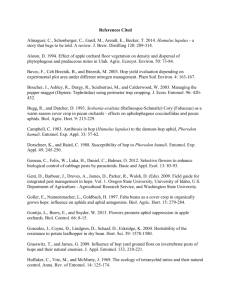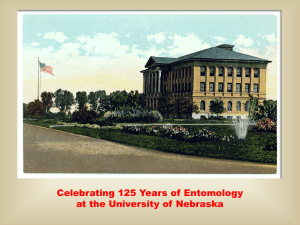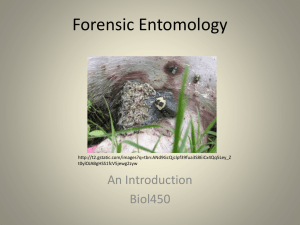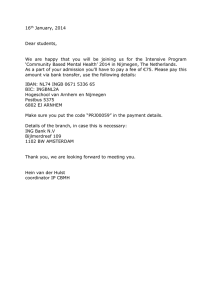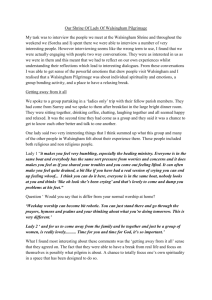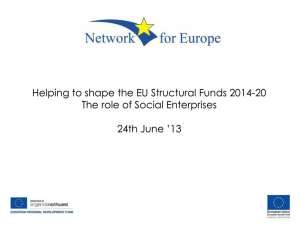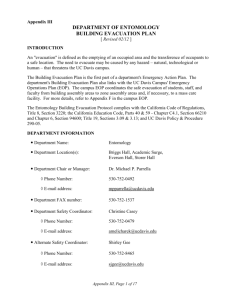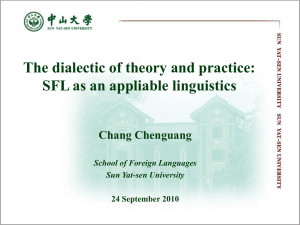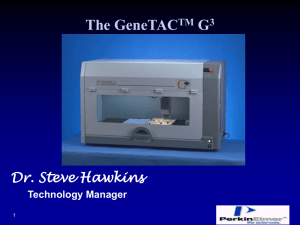Historical Lepidopterists
advertisement
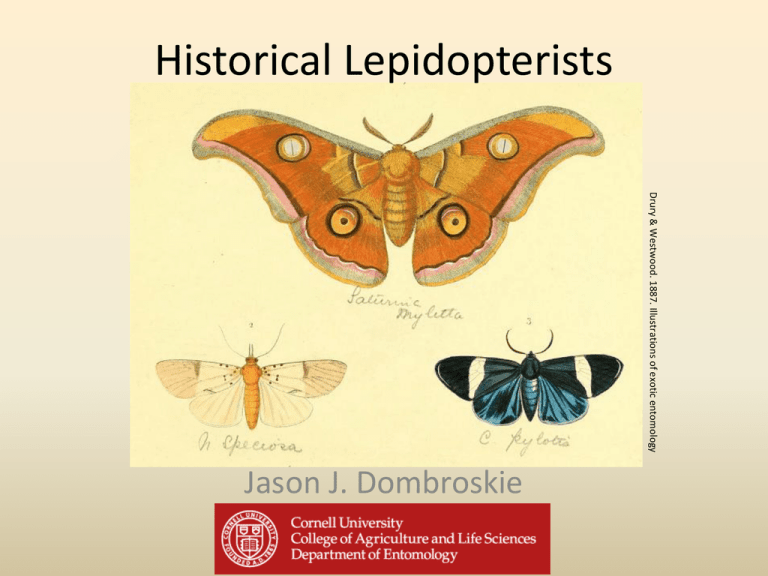
Historical Lepidopterists Drury & Westwood. 1887. Illustrations of exotic entomology Jason J. Dombroskie Jean Baptiste Boisduval (1799-1879) http://en.wikipedia.org/wiki/File:Dechauffour_de_Boisduval_1799-1879.jpg • Co-founder Société Entomologique de France • Mostly butterflies, other moths, beetles • Histoire général et iconographie des lepidoptérès et des chenilles de l’Amerique septentrionale (1837) • Sphingids in Carnegie Annette Frances Braun (1884-1978) • 1st woman awarded a PhD at U. of Cincinnati • vice-pres of Ent. Soc. Am. in 1926 • travelled extensively with her sister Dr. E. Lucy Braun (a botanist) in E. US • lived unmarried with her sister in a “strict Victorian lifestyle” • had a “science wing” on their property Kevin Guy Annette Frances Braun (1884-1978) • 4 monographs on microleps: Lithocolletis, Elachista, Bucculatrix, Tischeria (at 88 years old!) • amazing illustrations using only a hand lens and ancient microscope • collected 30 000 specimens of microleps August Busck (1870-1944) • educated in Denmark • worked as a florist, then for USNM, retired at Bishop • worked mainly with American microleps • Described over 600 spp. • Did not describe a new species unless real scientific or economic need for differentiation • Worked with Walsingham http://www.pwrc.usgs.gov/resshow/perry/bios/BusckAugust.htm August Busck (1870-1944) • Irritated the Brits: – wrote comments in the London Times about their unwillingness to accept the Walsingham collection – Busck about Sir Edwin Lankester: “...he confesses himself absurdly ignorant on the subject he undertakes to discuss” – Lankester shoots back: “we do not require fancy estimates of cash value of scientific objects from lepidopterists on the other side of the Atlantic” From: “Resents American Criticism” New York Times January 2, 1910 Smithsonian Institution Archives Dr. James Brackenridge Clemens (1825-1867) • Physician educated at the University of Pennsylvania • fascinated by all leps, especially good at rearing micros with detailed notes • thought Darwin’s theory of evolution was “flatly contradicted by all our physiological facts.” Clemens in various letters to T. S. Stainton Dr. James Brackenridge Clemens (1825-1867) “a study in which the artist's pencil comes to be an indispensible aid does not deserve the name of a science” “[the Tortricidae] is probably the most difficult, in a systematic point of view, and the least interesting family in the order of Lepidoptera" Clemens in a letter to T. S. Stainton William Henry Edwards (1822-1909) Weeks, A. G. 1910. Illustrations of diurnal lepidoptera. • studied law, then became pres. of the Ohio and Kanawha Coal Co. • His book “Voyage Up R. Amazon” inspired Wallace & Bates to visit the Amazon • specialized in diurnal leps • “The Butterflies of North America” (1897) • Over 250 scientific papers • Corresponded with Darwin, • Challenged Shakespeare’s authorship William Henry Edwards (1822-1909) • “It is not worth while for him to send me any more insects so miserably put up, and of such common species.” • [immediately following several paragraphs about describing species] “I have a singing mouse in a cage, caught in a trap in my bed room...when he sings his throat moves like a bird...when he is able to get out of the cage and run about the room, he sings all the time.” in a letter to S. F. Baird. 1960. J. N. Y. Entomol. Soc. (68) 157-175. Charles Henry Fernald (1838-1921) • First college prof of economic entomology (U. Mass. Amherst) • Best known for Gypsy Moth work, Crambidae + Pterophoridae revisions • Wide diversity of publications grasses to tuberculosis • Wife Maria studied Coccoidea, son Henry first chair Dept. Entomology Entomology and Zoology at Massachusetts Agricultural College Charles Henry Fernald (1838-1921) • Entered Maine Wesleyan Seminary to become a sea captain • “The Entomologist who broadens the horizon of his observations becomes better able to grasp and comprehend the great problems presented to him.” – Entomologist’s Monthly Magazine Augustus Radcliffe Grote (1841-1903) • worked extensively on North American macroleps, especially noctuids • spent his last 20 years in Germany where he died • Sold collection to BMNH, Buffalo Mus., USNM http://en.wikipedia.org/wiki/File:Augustus_Radcliffe_Grote_1841-1903.jpg Achille Guenée (1809-1880) • • • • Described 105 spp. of AB leps from wealthy family lawyer his collection survived the Franco-Prussian War, despite Châteaudun being burned • wrote 6 vol “Species des nocturnes” about noctuids worldwide Wilhelm Carl Paul Gottlieb Heinrich (1880-1955) • Studied Greek & drama, worked in business, then studied music • Worked for USDA • Nearctic Olethreutinae, Phycitinae, first to illustrate genitalia for Nearctic spp. Smithsonian Institution Jacob Hübner (1761-1826) • Designer & engraver, worked in Ukraine at cotton factory • Sammlung Europäischer Schmetterlinge (1796–1805) http://en.wikipedia.org/wiki/File:PortraitHuebner_.jpg Jacob Hübner (1761-1826) Cornell U. Mann Library Kolorierter Stich von de:Jacob Hübner, 1761-1826, aus: Das kleine Schmetterlingsbuch, Insel Verlag Leipzig, Seite 15 Rev. Dr. George Duryea Hulst (1846-1900) • Studied classics & theology at Rutgers • Minister plus botanist/entomologist • Missionary in Arabia, Hong Kong, China, India, Japan http://upload.wikimedia.org/wikipedia/commons/b/bc/George_Duryea_Hulst_1846-1900.jpg Rev. Dr. George Duryea Hulst (1846-1900) • macro & microlepidoptera, Catocala, Geometridae • “He had never had what might be termed a sick day, and by his lifelong habits of temperance had retained to a remarkable degree his boyish activity and sprightliness.” William Dunning Kearfott (1864-1917) • Was especially interested in Tortricidae • A mechanical engineer and well-known expert in his field • Had to give up work on microleps due to failing eyesight William Dunning Kearfott (1864-1917) • Developed many nonsense names – E. bobana E. cocana E. dodana E. fofana... – P. baracana P. caracana P. daracana P. faracana... – E. bandana E. candana E. dandana E. fandana... – E. bomonana E. comonana E. domonana... • Edward Meyrick was incensed by these names “based on barbarous and unmeaning gibberish” Dr. James Halliday McDunnough (1877-1962) • • • • • • • expert on leps and mayflies trained to learn violin in Germany played in Glasgow Orchestra studied zoology in Germany worked at Woods Hole Inst. curator of Barnes collection well known as a musician in Decateur, IL Dr. James Halliday McDunnough (1877-1962) • 1919 hired to organize the future CNC, worked for 28 years • collected across Canada • published 313 papers • 1946 worked at AMNH • moved to Halifax in 1950 Dr. James Halliday McDunnough (1877-1962) • “he showed little patience with new ideas and tended at times to be critical of anything he did not understand. He shunned meetings and social gatherings and perhaps for this reason had few scientific friends apart from immediate associates.” • “[he was] a meticulous person of superior manners, humour and generosity, combined with a manner of unusual frankness which, on occasions, probably led to misunderstandings of his personality” Dr. James Halliday McDunnough (1877-1962) • “most puzzling to me was his total disinterest in all other aspects of natural history...he did not even know the names of even the most familiar birds.” • “His favourite comment on genetics was the recitation of a limerick, unquotable in this context, illustrating Mendelian heredity.” Alpheus Spring Packard (1839-1905) • MD from Maine Med School • prof. of zoology and geology at Brown U. • strong proponent of NeoLamarckian evolution • 3 part Monograph of the Bombycine Moths of North America http://en.wikipedia.org/wiki/File:Alpheus-Spring-Packard-1839-1905.jpg Alpheus Spring Packard (1839-1905) • traveled through US & Labrador, Mexico, Europe, N. Africa • “...it was through professor Packard...[I] became aware of the existence of scientific activity at Brown University.” • “To contemplate the prolific labors of Professor Packard is to stand face to face with the attribute of genius. I do not wish to make an overstatement” John Bernhardt Smith (1858-1912) • worked as a lawyer, then for USDA • economic entomologist, authority on noctuids • “A bibliography of his systematic papers would fill many pages ; it is to be hoped that such will soon be prepared” Francis Walker (1809-1874) • worked for BMNH 1837-63 • 87 papers, catalogues for Orthoptera, Neuroptera, Homoptera, Diptera, Lepidoptera, Hymenoptera • one of the most prolific authors in entomology Francis Walker (1809-1874) • • • • • wealthy & educated family started collecting at the age of 9 collected all over Europe, esp. in mountains produced a ridiculous number of synonyms “More than twenty years too late for his scientific reputation, and after having done an amount of injury almost inconceivable in its immensity, Francis Walker has passed from among us” • politician and lord • coll. of 260 000 specimens • married 3 times, succeeded as baron by half-brother Subba, R. B. R. 1998. History of entomology in India. Institution of Agricultural Technologists, Bangalore. Thomas de Grey, 6th baron Walsingham (1843-1919) • avid sportsman • on trip to W. US, collected many micros • formed basis for his pterophorid revision National Portrait Gallery, London Thomas de Grey, 6th baron Walsingham (1843-1919) Philipp Christoph Zeller • taught himself entomology by copying books • degree in philology from U. Berlin • precise orderly approach to systematics • 13 vol. Natural history of the Tineinae • described 186 new genera • collection in BMNH http://en.wikipedia.org/wiki/File:Philipp_Christoph_Zeller_1808-1883.jpg References • • • • • • • • • • • Bethune, C. J. S. 1903. Death of Professor Grote. Can Entomol. 35:294 Bethune. C. J. S. 1909. William Henry Edwards. Can. Entomol. 41:215-248 Carrington, J. T. 1874. Entomol. Mon. Mag. 11: 140–141 Ferguson, D. C. 1962. James Halliday McDunnough (1877 – 1962) A Biographical Obituary and Bibliography. J. Lep. Soc. 16: 209-228. Gibson, A. 1912. Obituary John Bernhardt Smith. Can. Entomol. 44: 97-99 Gibson, A. 1918. Obituary Notice, William D. Kearfott. Can. Entomol. 50: 71-72. Gilligan, T. M., Wright, D. J., & Gibson, L. D. 2008. Olethreutine Moths of the Midwestern United States, An Identification Guide. Grinstein, L. S., Biermann, C. A., Rose, R. K. 1997. Women in the Biological Sciences: A Biobibliographic Sourcebook. Greenwood Publishing Group Kingsley, J. S. & C. Barus. 1905. Alpheus Spring Packard. Science 21: 401-405. Weeks, A. C. 1900. In Memoriam: Rev. Dr. George D. Hulst. J. N. Y. Ent. Soc. 8:248250. http://www.pwrc.usgs.gov/resshow/perry/bios/BusckAugust.htm Other Big Names • • • • • Johan Christian Fabricius (1745-1808) Carl Linnaeus (1707-1778) William Jacob Holland (1848-1932) Edward Meyrick (1854-1938) William Trowbridge Merrifield Forbes (18851968) Michael Denis (1729-1800) & Ignaz Schiffermüller (1727-1806) • Profs at Theresianum College in Vienna • das Systematische Verzeichnis der Schmetterlinge der Wienergegend herausgegeben von einigen Lehrern am k. k. Theresianum (1775) UNIVERSITY LIBRARY OF EÖTVÖS LORÁND UNIVERSITY, Budapest
